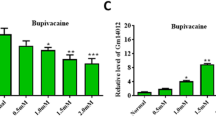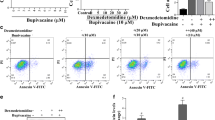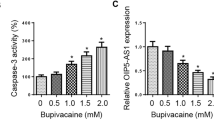Abstract
Bupivacaine (BUP) is a long-acting amide local anesthetic that may induce strong neurotoxicity and neurological complications. In this study, we elucidate the influence of microRNA-494-3p (miR-494-3p) in BUP-induced neurotoxicity in primary mouse hippocampal neuronal cells. In this study, primary hippocampal neurons were isolated from neonatal C57BL/6 mice. The isolated neurons were treated with various doses of BUP. MTT assay was conducted to analyze neuronal viability. Gene expression measurement was done by RT-qPCR. The impact of miR-494-3p in BUP-mediated neural injury was examined using TUNEL, flow cytometry, western blotting, and ROS activity detection. The regulatory relationship between miR-494-3p and cyclin-dependent kinases 4 and 6 (CDK6) was identified using a luciferase reporter assay. BUP treatment led to neurotoxicity and miR-494-3p upregulation in primary cultured hippocampal neurons. Functionally, miR-494-3p depletion alleviated neuronal apoptosis and oxidative damage induced by BUP. We verified that miR-494-3p targeted and negatively modulated CDK6. MiR-494-3p depletion also activated PI3K/AKT signaling by elevating CDK6 expression in BUP-treated neurons. Furthermore, CDK6 knockdown or PI3K/AKT inactivation attenuated the neuroprotective role of miR-494-3p depletion. Silencing miR-494-3p exerts neuroprotective function in hippocampal neuronal cells against BUP-induced injury by the CDK6-PI3K/AKT pathway.





Similar content being viewed by others
References
Alquézar C, Barrio E, Esteras N, de la Encarnación A, Bartolomé F, Molina JA, Martín-Requero Á (2015) Targeting cyclin D3/CDK6 activity for treatment of Parkinson’s disease. J Neurochem 133:886–897
Bao F, Kang X, Xie Q, Wu J (2019) HIF-α/PKM2 and PI3K-AKT pathways involved in the protection by dexmedetomidine against isoflurane or bupivacaine-induced apoptosis in hippocampal neuronal HT22 cells. Exp Ther Med 17:63–70
Bartel DP (2004) MicroRNAs: genomics, biogenesis, mechanism, and function. Cell 116:281–297
Beukelaers P, Vandenbosch R, Caron N, Nguyen L, Belachew S, Moonen G et al (2011) Cdk6-dependent regulation of G(1) length controls adult neurogenesis. Stem Cells 29:713–724
Caron N, Genin EC, Marlier Q, Verteneuil S, Beukelaers P, Morel L et al (2018) Proliferation of hippocampal progenitors relies on p27-dependent regulation of Cdk6 kinase activity. Cell Mol Life Sci 75:3817–3827
Cui C, Xu G, Qiu J, Fan X (2015) Up-regulation of miR-26a promotes neurite outgrowth and ameliorates apoptosis by inhibiting PTEN in bupivacaine injured mouse dorsal root ganglia. Cell Biol Int 39:933–942
D’Angelo B, Benedetti E, Cimini A, Giordano A (2016) MicroRNAs: a puzzling tool in cancer. Anticancer Res 36:5571–5575
Deng C, Zhu J, Yuan J, Xiang Y, Dai L (2020) Pramipexole inhibits MPP(+)-induced neurotoxicity by miR-494-3p/BDNF. Neurochem Res 45:268–277
Esteras N, Alquézar C, Bartolomé F, de la Encarnación A, Bermejo-Pareja F, Molina JA et al (2015) G1/S cell cycle checkpoint dysfunction in lymphoblasts from sporadic Parkinson’s disease patients. Mol Neurobiol 52:386–398
Fan YL, Li HC, Zhao W, Peng HH, Huang F, Jiang WH et al (2016) Curcumin attenuated bupivacaine-induced neurotoxicity in SH-SY5Y cells via activation of the Akt signaling pathway. Neurochem Res 41:2425–2432
Geng L, Zhang T, Liu W, Chen Y (2018) miR-494-3p modulates the progression of in vitro and in vivo Parkinson’s disease models by targeting SIRT3. Neurosci Lett 675:23–30
Heller G, Nebenfuehr S, Bellutti F, Ünal H, Zojer M, Scheiblecker L et al (2020) The effect of CDK6 expression on DNA methylation and DNMT3B regulation. iScience 23:101602
Lee YM, Song BC, Yeum KJ (2015) Impact of volatile anesthetics on oxidative stress and inflammation. Biomed Res Int 2015:242709
Li L, Zhang QG, Lai LY, Wen XJ, Zheng T, Cheung CW et al (2013) Neuroprotective effect of ginkgolide B on bupivacaine-induced apoptosis in SH-SY5Y cells. Oxid Med Cell Longev 2013:159864
Lin H, Huang ZP, Liu J, Qiu Y, Tao YP, Wang MC et al (2018) MiR-494-3p promotes PI3K/AKT pathway hyperactivation and human hepatocellular carcinoma progression by targeting PTEN. Sci Rep 8:10461
Liu AJ, Zang P, Guo JM, Wang W, Dong WZ, Guo W et al (2012) Involvement of acetylcholine-α7nAChR in the protective effects of arterial baroreflex against ischemic stroke. CNS Neurosci Ther 18:918–926
Lu J, Xu SY, Zhang QG, Lei HY (2011) Bupivacaine induces reactive oxygen species production via activation of the AMP-activated protein kinase-dependent pathway. Pharmacology 87:121–129
Mi D, Carr CB, Georgala PA, Huang YT, Manuel MN, Jeanes E et al (2013) Pax6 exerts regional control of cortical progenitor proliferation via direct repression of Cdk6 and hypophosphorylation of pRb. Neuron 78:269–284
Oliveros ML, de la Osa RMR (2021) Bupivacaine infiltration for acute postoperative pain management after cardiac surgery. Nurs Crit Care. https://doi.org/10.1111/nicc.12614
Radwan IA, Saito S, Goto F (2002) The neurotoxicity of local anesthetics on growing neurons: a comparative study of lidocaine, bupivacaine, mepivacaine, and ropivacaine. Anesth Analg 94:319–324
Rudolph AM (1995) Pharmacodynamics in the maternal-fetal-placental unit. NIDA Res Monogr 154:163–174
Srivastava SK, Bhardwaj A, Leavesley SJ, Grizzle WE, Singh S, Singh AP (2013) MicroRNAs as potential clinical biomarkers: emerging approaches for their detection. Biotech Histochem 88:373–387
Tan XH, Zhang KK, Xu JT, Qu D, Chen LJ, Li JH et al (2020) Luteolin alleviates methamphetamine-induced neurotoxicity by suppressing PI3K/Akt pathway-modulated apoptosis and autophagy in rats. Food Chem Toxicol 137:111179
Twaroski D, Bosnjak ZJ, Bai X (2015) MicroRNAs: new players in anesthetic-induced developmental neurotoxicity. Pharm Anal Acta 6:357
Wang X, Ding G, Lai W, Liu S, Shuai J (2018) MicroRNA-383 upregulation protects against propofol-induced hippocampal neuron apoptosis and cognitive impairment. Exp Ther Med 15:3181–3188
Wang Y, Gu J, Hu L, Kong L, Wang T, Di M et al (2020) miR-130a alleviates neuronal apoptosis and changes in expression of Bcl-2/Bax and caspase-3 in cerebral infarction rats through PTEN/PI3K/Akt signaling pathway. Exp Ther Med 19:2119–2126
Xin H, Liu N, Xu X, Zhang J, Li Y, Ma Y et al (2019) Knockdown of lncRNA-UCA1 inhibits cell viability and migration of human glioma cells by miR-193a-mediated downregulation of CDK6. J Cell Biochem 120:15157–15169
Xing Y, Zhang N, Zhang W, Ren LM (2018) Bupivacaine indirectly potentiates glutamate-induced intracellular calcium signaling in rat hippocampal neurons by impairing mitochondrial function in cocultured astrocytes. Anesthesiology 128:539–554
Xiong R, Wang Z, Zhao Z, Li H, Chen W, Zhang B et al (2014) MicroRNA-494 reduces DJ-1 expression and exacerbates neurodegeneration. Neurobiol Aging 35:705–714
Yang F, Zhang Y, Tang Z, Shan Y, Wu X, Liu H (2020) Hemin treatment protects neonatal rats from sevoflurane-induced neurotoxicity via the phosphoinositide 3-kinase/Akt pathway. Life Sci 242:117151
Yu XJ, Zhao W, Li YJ, Li FX, Liu ZJ, Xu HL et al (2017) Neurotoxicity comparison of two types of local anaesthetics: amide-bupivacaine versus ester-procaine. Sci Rep 7:45316
Yuan L, Feng F, Mao Z, Huang J, Liu Y, Li Y et al (2020) Effects of Erbuzhuyu decoction combined with acupuncture on endometrial receptivity are associated with the expression of miR-494-3p. Evid Based Complement Alternat Med 2020:9739672
Zhang H, Wang W, Du Q (2019) Andrographolide attenuates bupivacaine-induced cytotoxicity in SH-SY5Y cells through preserving Akt/mTOR activity. Drug Des Devel Ther 13:1659–1666
Zhang L, Wang Z, Li B, Xia Z, Wang X, Xiu Y et al (2020) The inhibition of miR-17-5p promotes cortical neuron neurite growth via STAT3/GAP-43 pathway. Mol Biol Rep 47:1795–1802
Zhang X, Yang Q, Zhang Z (2017) The efficiency and safety of local liposomal bupivacaine infiltration for pain control in total hip arthroplasty: A systematic review and meta-analysis. Medicine (Baltimore) 96:e8433
Zhao H, Li G, Wang R, Tao Z, Ma Q, Zhang S et al (2020) Silencing of microRNA-494 inhibits the neurotoxic Th1 shift via regulating HDAC2-STAT4 cascade in ischaemic stroke. Br J Pharmacol 177:128–144
Zhu H, Xie R, Liu X, Shou J, Gu W, Gu S et al (2017) MicroRNA-494 improves functional recovery and inhibits apoptosis by modulating PTEN/AKT/mTOR pathway in rats after spinal cord injury. Biomed Pharmacother 92:879–887
Zimmer C, Piepenbrink K, Riest G, Peters J (2007) Cardiotoxic and neurotoxic effects after accidental intravascular bupivacaine administration. Therapy with lidocaine propofol and lipid emulsion. Anaesthesist 56:449–453
Author information
Authors and Affiliations
Corresponding author
Ethics declarations
Conflict of Interest
The authors declare no competing interests.
Additional information
Publisher's Note
Springer Nature remains neutral with regard to jurisdictional claims in published maps and institutional affiliations.
Rights and permissions
About this article
Cite this article
Zhang, L., Zhang, L. & Guo, F. MiRNA-494-3p Regulates Bupivacaine-Induced Neurotoxicity by the CDK6-PI3K/AKT Signaling. Neurotox Res 39, 2007–2017 (2021). https://doi.org/10.1007/s12640-021-00427-w
Received:
Revised:
Accepted:
Published:
Issue Date:
DOI: https://doi.org/10.1007/s12640-021-00427-w




